It might seem like a given that people who have experienced a major fire think they are at greater risk of wildfire. It’s common to hear anecdotes of living through a wildfire acting as a “wakeup call” for WUI residents to start mitigating the wildfire risks on their property. Indeed, conventional wisdom holds that risk perceptions increase substantially after a large wildfire.
In September 2010, we were in a position to make the most of unfortunate events by looking at how residents’ wildfire-related perceptions, attitudes, and actions change after fire. Two catastrophic fires on Colorado’s Front Range, the Fourmile Canyon Fire in Boulder County and the Reservoir Road Fire in Larimer County, hit communities that had previously been surveyed about wildfire in 2007. To see how things might have changed for residents, another survey was sent in November 2010 to respondents to the original survey. Two out of every three people filled out this second survey.
Contrary to popular wisdom, we found that risk perceptions did not change very much between the two surveys; the catastrophic fires served neither as a “wakeup call” nor as a risk “letdown” for the people who experienced them. Measures of the chance of wildfire occurring (probability) and of the chance of negative outcomes like one’s home being destroyed (consequence) did not change significantly. Perhaps the fire was not a wake up call because respondents had fairly high risk perceptions even before the 2010 fires. At the same time, residents did not adjust their perceptions down as one might expect if they felt that “lightning won’t strike twice” or if they thought that the fires reduced available fuels (which would be true only for the approximately 5% of respondents living within the actual burn perimeters).
As we discuss further in our related paper, measures of the perceived probability and consequence each relate to different sets of factors. Neither changed substantially after a major fire, but both are related to things that tend not to change much over time, such as learning from neighbors and recognizing the spread of wildfire risk across property lines.
Source: Champ and Brenkert-Smith (2015). Is seeing believing? Perceptions of wildfire risk over time. Risk Analysis. DOI: 10.1111/risa.12465
